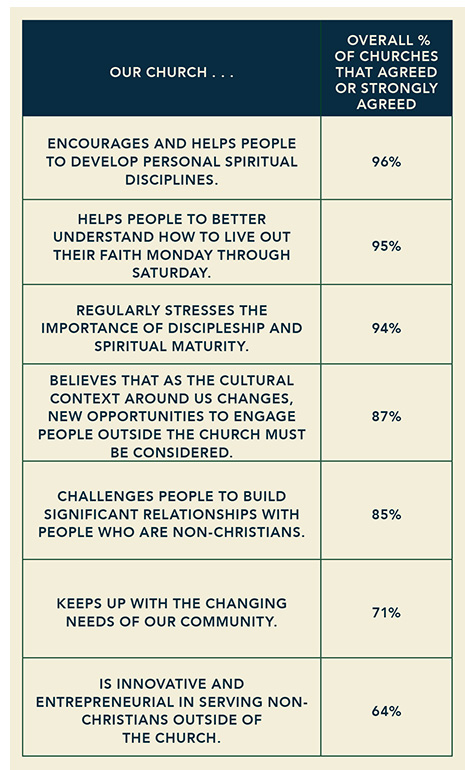
By Kent E. Fillinger
The term “new normal” first appeared during the 2008 financial crisis. It refers to the dramatic economic, cultural, and social transformations that caused instability and social unrest, impacting collective perceptions and individual lifestyles. This term was used again during the COVID-19 pandemic to point out how it transformed essential aspects of human life and church practices.
The pandemic caused some churches to refocus or redefine their ministry practices. It caused some Christians to reshape their spiritual habits and practices. Four years removed now from the pandemic’s onset, our annual church survey helps to shine a light on where we stand as a movement of churches.
This year, 314 churches ranging in size from 10 to almost 50,000 in weekly attendance completed our annual survey by sharing 2023 data; we collected standard information like attendance, baptisms, and giving to note emerging trends and to provide insights into the spiritual practices of believers. (Click here to access the church charts.)
Small Groups, Spiritual Disciplines & Serving with Your Gifts
Past surveys asked churches to identify the methods they use for adult discipleship or spiritual formation, but for the first time, we asked churches to approximate the percentage of adult regular attendees who are connected with a small group of people for Bible study.
Overall, churches estimated that 44 percent of their adult regular attendees are connected to a small-group Bible study. Emerging megachurches (average weekly worship attendance of 1,000 to 1,999) led the way with an estimated 53 percent connected to a group Bible study, while very small churches (99 or fewer in weekly attendance) reported the smallest percentage, 37 percent. The overall responses from individual churches ranged from 3 percent to 88 percent.
By comparison, a September 2022 Lifeway Research study titled “Church Health Indicators in Protestant Churches” reported that same percentage, 44 percent, of current weekend worship attendees were involved in a small group, Sunday school, or similar group. This was a decline from 49 percent in average small group attendance in 2010.
Another new question we asked: Approximately, what percentage of your adult regular attendees would you say are pursuing spiritual habits that are helping them to model their life after Jesus?
The churches responded by saying that over half (52 percent) of their adult regular attendees were pursuing spiritual habits to help them model their life after Jesus. Medium size churches (averaging 250 to 499 weekly) reported the highest percentage of attendees pursuing such habits, 55 percent, while megachurches (2,000 or more weekly) listed the smallest percentage, just under 50 percent. Responses from individual churches ranged from 10 percent to 95 percent.
We also asked churches to identify approximately what percentage of your adult regular attendees are using their spiritual gifts to serve on a regular basis?
Overall, the churches said 43 percent of their adult attendees were regularly serving and using their spiritual gifts. Megachurches reported the greatest use of gifts and participation by serving, 45 percent, and large churches (averaging 500 to 999) listed the lowest, 40 percent. Responses from individual churches ranged from 10 percent to 90 percent.
The 2022 Lifeway Research study reported 42 percent of adults in Protestant churches volunteer regularly.
For the first time in almost two decades, we asked several questions related to Bible reading, Bible engagement, and biblical literacy to assess how church leaders viewed the habits and practices of their congregations.
Bible Reading Habits
We asked, “In the past year, for your adult regular attendees, approximately what percentage would say their Bible reading has ‘stayed the same,’ ‘increased,’ or ‘decreased’?”
Churches estimated the amount of time spent reading the Bible “stayed the same” for more than half (54 percent) of their adult regular attendees last year. It was estimated that Bible reading “increased” for 34 percent of church members and “decreased” for 12 percent.
By comparison, the American Bible Society’s 2023 State of the Bible report found that only about 14 percent of Americans said they increased their Bible use in the past year. The same study showed that only 25 percent of the population reads the Bible weekly on their own, apart from a church service. Among denominational groupings, however, evangelicals lead the way with more than half (53 percent) using the Bible weekly.
More than half of Americans (52 percent) said they wished they used the Bible more, and nearly three in four Americans (71 percent) said they are curious about the Bible and/or Jesus.
So, what keeps people from connecting with the Bible? The State of the Bible survey asked people to identify two significant frustrations from among nine possibilities. The frustrations chosen most were: “I never seem to have enough time to use it” (26 percent), “I don’t know where to start” (17 percent), “I don’t feel that excited about using it” (15 percent), and “I find the language difficult to relate to” (15 percent).
Three Categories of Bible Engagement
The State of the Bible survey uses three categories to describe people’s relationship to and involvement with the Bible. We adopted their categories and asked our churches to approximate what percentage of their adult regular attendees fit each of the following categories:
- Scripture Engaged—The Bible impacts their daily lives, helps guide their relationships with God and others, and they regularly read, listen to, and engage with the Bible.
- Movable Middle—These people range from those who sporadically interact with the Bible on the low end, to those who periodically open the Bible as a source of spiritual insight and wisdom.
- Bible Disengaged: People in this category interact infrequently with the Bible, and it has minimal influence in their lives. “Bible Disengaged” people rarely seek out the Bible, and tend to encounter it through others, rather than by choice.
The 2023 State of the Bible report said 18 percent of Americans classified themselves as “Scripture Engaged,” down from 28 percent in 2020 (from a survey completed before the pandemic).
By comparison, 45 percent of the churches overall in our survey said their regular adult attendees were “Scripture Engaged.” Over half (53 percent) of the very small churches classified their congregation as “Scripture Engaged,” which was the highest percentage for any of the church size categories.
The State of the Bible report listed 29 percent of Americans as part of the “Moveable Middle” category, which increased from 26 percent in 2020. The churches in our survey surmised that 35 percent of their regular adult attendees were in the “Moveable Middle.” Emerging megachurches said that 38 percent of their adults were in the “Moveable Middle,” which was the highest percentage noted.
Finally, the State of the Bible report noted that over half (53 percent) of Americans qualify as “Bible Disengaged.” Sadly, this percentage has increased from 46 percent in 2020. But our survey participants estimated that only one in five (20 percent) of their regular adult attendees fit the “Bible Disengaged” category. Large churches reported the largest percentage of “Bible Disengaged” attendees, with 24 percent.
The top three motivations cited for reading the Bible in the State of the Bible survey were: “It brings me closer to God” (47 percent), “I need wisdom for making life decisions” (20 percent), and “I need comfort” (15 percent).
How Do Churches Encourage Bible Reading?
Our survey asked churches to identify which methods they use to encourage their congregations to read the Bible on their own. The top two responses were by providing reminders to read the Bible in sermons (94 percent) and by providing free Bibles to those needing one (85 percent). Just over three-fourths of the churches (77 percent) said they provide Bible reading plans (print, digital, or online) to their congregation. And the least used methods for promoting Bible reading were through providing reminders by email, e-newsletters, or print newsletters (60 percent) and by putting reminders on the church’s or ministry staff’s social media platforms (54 percent).
How Biblically Literate Is Your Church?
Our survey asked churches to estimate what percentage of their adult regular attendees would qualify as being “biblically literate” using this definition: “Biblical literacy is the ability to rightly read and understand the Bible using the proper tools of study to become better acquainted with its essential nature and content and then apply discerned meaning to life. It involves a person’s ability to read the Bible with enough understanding to explain its basic meaning.”
Just over half (51 percent) of the churches responding said their adult regular attendees were biblically literate. Individual church responses ranged from 10 percent to 95 percent. Very small churches reported the highest percentage of biblically literate attendees with 57 percent. Emerging megachurches noted the lowest percentage of biblically literate attendees with 48 percent.

What Percentage of Your Church Has a Biblical Worldview?
We also asked, “Approximately what percentage of your adult regular attendees would you say have a ‘biblical worldview’ using the following definition?: ‘A biblical worldview is a view of the world which seeks to answer life’s biggest questions from the teachings of the Bible, with a special focus on the gospel storyline.’”
Overall, the churches estimated that 57 percent of their congregants had a “biblical worldview.” Once again, very small churches led the way with 64 percent and emerging megachurches reported the lowest percentage with 52 percent.
These findings are especially interesting considering the 2023 American Worldview Inventory conducted by the Cultural Research Center at Arizona Christian University, which found that only 4 percent of Americans have a biblical worldview, down from 6 percent in 2020.
Churches we surveyed were asked to respond with “strongly disagree,” “disagree,” “uncertain,” “agree,” or “strongly agree” to the following statements about their church. Listed below are the overall percentages of churches that responded with either “agree” or “strongly agree.” For each of the statements, the larger the church, the more likely the responses were “agree” or “strongly agree.”
Baptisms Bounce Back
Last year, I noted in “The Christian Standard Church Report for 2022: A Year of Transition” that the average number of baptisms per church increased by 7 percent in 2022 compared with the year prior, but it was still 28 percent lower than the pre-pandemic numbers in 2019. I suggested,
The number of baptisms doesn’t correspond to the strong growth rates recorded over the last one to three years. An optimist might argue we are on the verge of a surge in baptisms as new attendees continue to hear the gospel in these churches. But a pessimist might counter that attendance growth possibly was driven by transfers, as people decided to leave their former church during or after the pandemic. Perhaps it’s a combination of the two.
The good news for now is there was a strong resurgence in the number of baptisms in 2023, which eclipsed the 2019 pre-pandemic numbers in almost every way. In 2019, the 439 reporting churches recorded 32,139 baptisms, for an average of 73 baptisms per church. This past year, the 314 churches baptized 28,657—an average of 91 per church—a 25 percent increase from 2019.
The overall baptism ratio (number of baptisms per 100 people in average worship attendance) was 6.5, a 20 percent increase over 2019, when it was 5.4.
It’s impossible to discern if 2023 was an anomaly or if the tide is turning and stronger baptism numbers will continue.
Attendance & Growth
Overall, 79 percent of the churches grew last year, while the remaining 21 percent declined in attendance. Among emerging megachurches, 92 percent of them grew, which was the highest percentage in our survey, while very small churches had the smallest percentage of growing churches, 64 percent.
Emerging megachurches grew an average of 25.2 percent last year, which was the best growth rate for any of the six categories of churches. Small churches (averaging 100 to 249 weekly) had the slowest growth rate at 8.5 percent in 2023. Overall, churches averaged 13 percent growth last year, which tied the growth rate from 2022.
Online worship attendance continued to shrink. In 2022, online attendance represented 28 percent of the total average worship attendance. That percentage slipped to 23 percent in 2023, as more people continued to return for in-person worship services. In 2022, 9 percent of the churches reported an online attendance greater than their in-person attendance. But, last year, that number dropped to 4 percent. Also worth noting, three-fourths (76 percent) of the churches surveyed reported online attendance figures.
Overall average in-person attendance grew by 8 percent last year when compared with 2022. Megachurches saw the biggest increase with 20 percent more in-person attendees on average in 2023.
I will share a deep dive into the financial health of our churches in the July/August issue.





Bruce Webster, a disciple multiplication trainer/coach, and a kingdom expansion consultant/coach, shared this with us via email:
“More than 50 years ago as a grad student in social science research classes at Michigan State, I learned that even the best survey data tells you nothing about the people (or churches) that don’t respond. Kent Fillinger has good data on the churches that responded to his survey. However, he has no data on the more than 90% of our churches that didn’t respond. Every 10 years the Association of Statisticians of American Religious Bodies (ASARB) does a national county by county report on religious bodies (churches, mosques, synagogues, etc.) by affiliation. According to the ASARB data our brotherhood declined by nearly 700 churches (-12.5%) and over 60,000 adherents (-4.2%) between 2000 and 2020. (Because we have no centralized data collection, our ASARB data is not as good as for most other groups.) Only God really knows how we are doing. . . .”